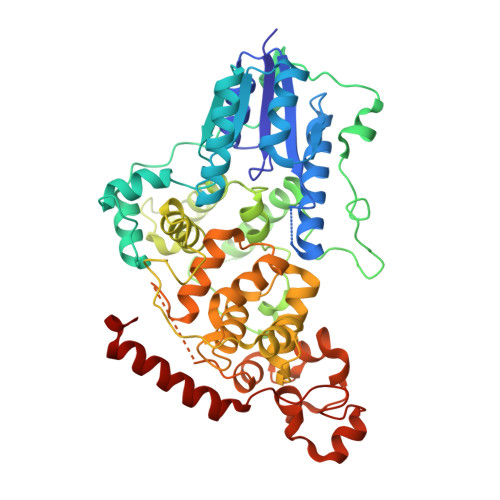A methylbenzimidazole derivative regulates mammalian circadian rhythms by targeting Cryptochrome proteins.
Yagi, M., Miller, S., Nagai, Y., Inuki, S., Sato, A., Hirota, T.(2022) F1000Res 11: 1016-1016
- PubMed: 36226040
- DOI: https://doi.org/10.12688/f1000research.124658.2
- Primary Citation of Related Structures:
7WVA - PubMed Abstract:
Background : Impairment of the circadian clock has been associated with numerous diseases, including sleep disorders and metabolic disease. Although small molecules that modulate clock function may form the basis of drug discovery of clock-related diseases, only a few compounds that selectively target core clock proteins have been identified. Three scaffolds were previously discovered as small-molecule activators of the clock protein Cryptochrome (CRY), and they have been providing powerful tools to understand and control the circadian clock system. Identifying new scaffolds will expand the possibilities of drug discovery. Methods : A methylbenzimidazole derivative TH401 identified from cell-based circadian screens was characterized. Effects of TH401 on circadian rhythms were evaluated in cellular assays. Functional assays and X-ray crystallography were used to elucidate the effects of the compound on CRY1 and CRY2 isoforms. Results : TH401 lengthened the period of circadian rhythms and stabilized both CRY1 and CRY2. The compound repressed Per2 reporter activity, which was reduced by Cry1 or Cry2 knockout and abolished by Cry1/Cry2 double knockout, indicating the dependence on CRY isoforms. Thermal shift assays showed slightly higher interaction of TH401 with CRY2 over CRY1. The crystal structure of CRY1 in complex with TH401 revealed a conformational change of the gatekeeper W399, which is involved in isoform-selectivity determination. Conclusions : The present study identified a new small molecule TH401 that targets both CRY isoforms. This compound has expanded the chemical diversity of CRY activators, and will ultimately aid in the development of therapeutics against circadian clock-related disorders.
- Institute of Transformative Bio-Molecules, Nagoya University, Nagoya, 464-8601, Japan.
Organizational Affiliation:

















